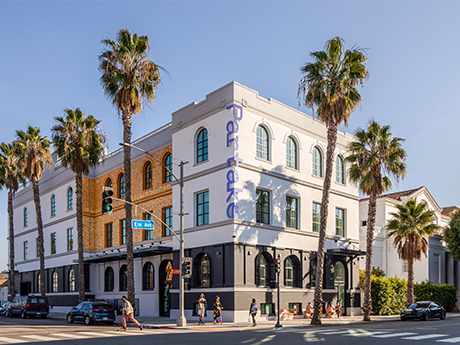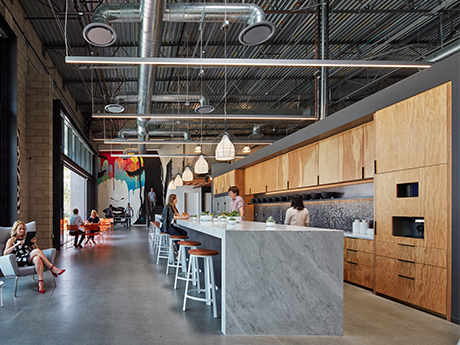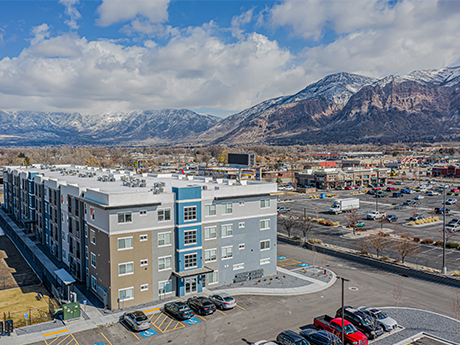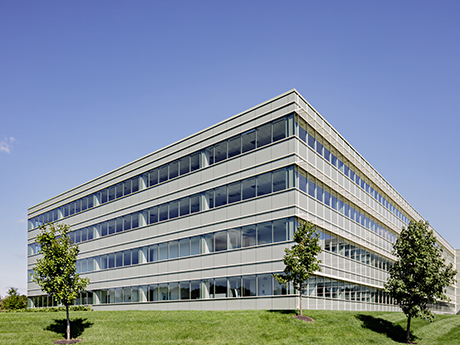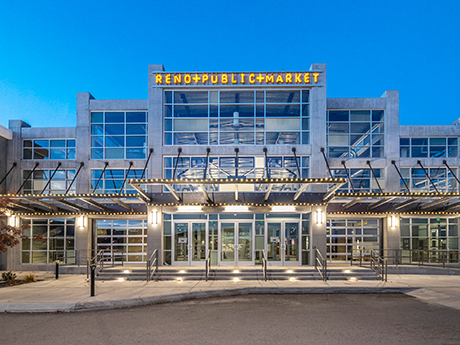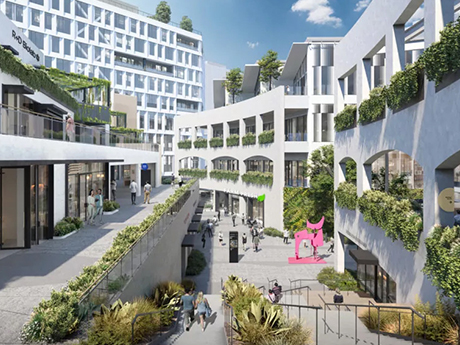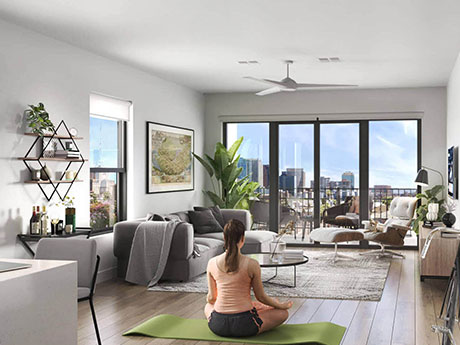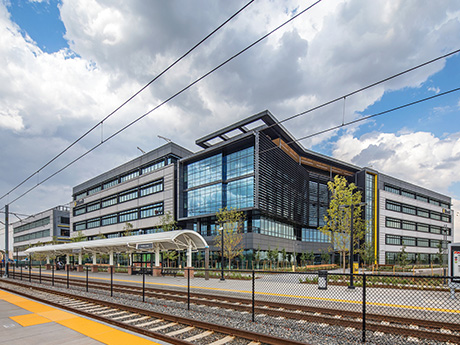— By Elise Kunihiro and Maura Schafer — Historic building adaptive reuse creates a bridge between the past and the future, resulting in places that can become the hearts and souls of their communities. The reuse of these buildings offers community benefits, such as sustainability, new public spaces and character. Reactivate local economies Beyond revitalizing older buildings, adaptive reuse projects can also support small local business owners. A 1922 brick office building in the East Village Arts District of downtown Long Beach, Calif., for example, now hosts Partake Collective. The 25,000-square-foot cloud concept and food hall incubator allows visitors to support local restauranteurs while dining in a communal food hall or sidewalk dining area. Studio One Eleven served as the project’s architect, while RDC did interiors and procurement. The goal of this redevelopment model was to create a benchmark for future development that celebrates food diversity and enhances community building. It doesn’t hurt that Partake Collective remains an active and engaged member of the Long Beach community by working with local educational institutions to support pathways to private enterprise, business ownership and job opportunities for the most underrepresented communities. Partake Collective has already partnered with culinary programs at Browning High …
Western Feature Archive
— By Carina Mills and Maura Schafer — In 2017, partner design firms RDC and Studio One Eleven (RDC-S111) relocated from a high-rise office to a former 25,000-square-foot Nordstrom Rack at 245 E. Third Street in downtown Long Beach, Calif. The store was located in a 1980s-era shopping center that had fallen into serious decline. On the plus side, the location was consistent with Studio One Eleven’s mission of urban repair, allowing for a pedestrian-level interaction with the neighborhood, while strengthening the city fabric. Soon enough, the retail space was converted into a modern creative office that added 130 design professionals to the neighborhood’s daytime population. This higher-use conversion occurred alongside other public and private investments that brought restaurants into the area. These included Ammatoli (a Los Angeles Times Top 100 restaurant), Beachwood Brewery, Rainbow Juices and Michael’s Pizzeria, among others. The adjacent Harvey Milk Park garnered grants for a reinvigoration by Studio One Eleven, and developers started working on housing development around the immediate neighborhood. This move and project was not only a chance for RDC and Studio One Eleven to create urban impact, but to design an environment for staff that instills creativity, collaboration and wellness. The office achieved …
— By Brett Silverstein — With uncertainty looming large and terms like risk, crash and recession swirling around the industry, it comes as no surprise that some investors are clinging to their cash reserves. But savvy investors go back to the fundamentals of the real estate cycle. While the economic conditions that influence the cycle are often different, such as the Dot-Com bubble, the Global Financial Crisis and, most recently, COVID, the predictability of the real estate cycle is consistent. In my opinion, a sound acquisitions strategy today is one grounded in acquiring high-quality assets below replacement cost in Intermountain West markets that exhibit strong fundamentals, such as outsized rent growth, continued strong household formation patterns and limited future supply growth. Distress leads to discounts Amidst the prevailing market turbulence, the acquisition of existing assets at a discount to the cost of building new ones becomes an even more compelling proposition. Replacement cost alone may not suffice as an investment metric, but the combination of discounted prices and robust market fundamentals creates the secret sauce of sound investment decisions. Housing is an essential good that is always in demand and has historically inflated over time. The foundational concept of “heads …
Converting Office to Life Sciences Offers Lucrative Alternative to Residential Reuse Projects
by Jeff Shaw
— By Julian Freeman, Dave Wensley and Gabe Pitassi — With steep vacancy rates impacting traditional office markets due to the headwinds of higher interest rates, short-term economic uncertainty and long-term remote/hybrid work uncertainties, underutilized traditional office buildings may become liabilities before the end of their anticipated economic life. Owners of these properties may consider a conversion — an adaptive reuse or repurposing — to access higher rents and occupancy rates. In view of nationwide housing shortages, especially in California, converting office to multifamily has received much attention as a logical move. However, such a conversion is not always viable from a financial, structural, legal or location perspective. An alternative option may be to repurpose an office building for life sciences use. Such a conversion, while posing its own unique challenges, may provide more realistic options than a conversion to residential use for many owners and properties. Challenges in converting to residential Converting an office building to residential use presents challenges on multiple fronts. Zoning laws vary based on property location and usage, and the property may need to be rezoned to a different classification to allow multifamily uses. Rezoning requires local government approval and public hearings, which can take months …
FeaturesHeartland Feature ArchiveMultifamily & Affordable Housing Feature ArchiveNortheast Feature ArchiveSoutheast Feature ArchiveTexas & Oklahoma Feature ArchiveWestern Feature Archive
Forecast Survey: What’s Your Take on Commercial Real Estate in 2024?
by John Nelson
The editors of REBusinessOnline.com are conducting a brief online survey to gauge market conditions in 2024, and we welcome your participation. The survey should only take a few minutes to complete. Questions range from property sectors that you are most bullish on heading into 2024 to trends in deal volume to your outlook for interest rates. The results of our 13th annual survey will be compiled and published in the January issues of our regional magazines. Conducting these surveys is part of our mission at France Media to provide readers with indispensable information, and we couldn’t do it without your help. To participate in our broker/agent survey, click here. To participate in our developer/owner/manager survey, click here. To participate in our lender/financial intermediary survey, click here. (Note: Please remember to click on “done” to properly submit the survey.)
By Dan Spiegel of Coldwell Banker Commercial As we enter an age where online shopping dominates the retail landscape, a recurring discussion in commercial real estate is what part malls play in this new world, if any part at all. More and more malls are “dying out,” which creates a difficult challenge for property owners as conventional indoor malls are no longer a commodity due to constantly evolving shopping trends. My team and I work with retail property owners and buyers at Coldwell Banker Commercial to address these difficulties and help build a new future for successful mall properties. Thankfully, there are a few key strategies property owners can implement to save their shopping centers from becoming obsolete. One of these strategies includes renovating a mall to create new stores and experiences, repositioning the space as a social destination for recreation. Another involves transforming shopping centers into mixed-use spaces, adding apartments and multifamily units to increase foot traffic and provide people with access to shopping, housing and other essential services. Older Properties, New Market The Reno Public Market in Reno, Nev., is a great case study that demonstrates one of the ways in which property owners can adapt to current …
— By Bob Lisauskas, Principal, RDC in Long Beach, Calif. — Daily patterns of life have been turned upside down since 2020. Three years since the disruption of quarantine living, it’s becoming clear what was temporary and what has been permanently changed. The good news: our cities have the potential to come back healthier than ever. Cities are resilient places and are finding ways to adapt and transform. Building owners, municipalities, architects and other stakeholders are actively collaborating on ways to repair the city fabric. While some of these companies and individuals have fled to the suburbs, many are more committed than ever to preserve urban living. This is often because they love the city where they own their property, and are personally motivated to breathe life into the area. Another wrinkle driving urban transformation is the housing crisis. It’s an urgent reality that we need more housing at every price point in our urban centers. This is something that’s of paramount concern, particularly in California, as rents and property values rise. These, along with other trends and market disruptors, are pushing cities toward a primarily mixed-use future in which new developments serve the entire 24-hour cycle: living, working, shopping …
FeaturesHeartland Feature ArchiveNortheast Feature ArchiveOtherSoutheast Feature ArchiveTexas & Oklahoma Feature ArchiveWestern Feature Archive
Forecast Survey: What’s Your Take on Commercial Real Estate in 2023?
by John Nelson
The editors of REBusinessOnline.com are conducting a brief online survey to gauge market conditions in 2023, and we welcome your participation. The survey should only take a few minutes to complete. Questions range from property sectors that you are most bullish on heading into 2023 to trends in deal volume to your outlook for interest rates. The results of our 12th annual survey will be collated and published in the January issues of our regional magazines. Conducting these surveys is part of our mission at France Media to provide readers with indispensable information, and we couldn’t do it without your help. To participate in our broker/agent survey, click here. To participate in our developer/owner/manager survey, click here. To participate in our lender/financial intermediary survey, click here. (Note: Please remember to click on “done” to properly submit the survey.)
By Barry Manuel, CIO, MEB Management Services Did you know that 39 percent of energy-related carbon dioxide emissions are generated through manufactured buildings? We spend the majority of our lives using indoor spaces to gather, work, socialize and live, which means multifamily developers and managers need to consider environmentally friendly options that don’t contribute to the global climate crisis. It’s the right thing to do, and we’re not the only ones who know that. Residents are getting wise to the impact their buildings play in the climate crisis. Creating A Solution With this in mind, we recently created the MEB Sustainability Committee to address environmental issues and adapt sustainability practices for our multifamily properties throughout Arizona and New Mexico. Our goal is to have at least 75 percent of all MEB properties engaged in energy-saving initiatives. MEB is taking a two-pronged approach. We’re using ESG ratings to measure long-term environmental, social and governance risks while educating and sharing sustainable practices with our residents and management teams. Through a collaborative effort, we’re reducing emissions by making changes to both new and existing apartment buildings. Part of our strategy and collaboration involves partnering with one of the most sustainably conscious builders in Arizona …
By Michael Brumley, Project Executive, Kiewit Building Group AT The pandemic sent ripple effects throughout the construction industry. Along the way, it also heavily influenced and impacted the way employees in the workforce now operate and interact. With COVID prompting a shift in remote work, many are wondering if it’s beneficial to go back to the office full-time, adopt a hybrid approach or forgo investing in office space altogether. There are many justifications for investing in office space when you consider variables like productivity, industry-specific jobs or trades, and overall employee satisfaction and benefits. The distinction is you need to invest in spaces that are successful for employers and employees alike. It’s All About the Benefits The pandemic proved work can be done anywhere as long as Wi-Fi is available. So, how can companies entice employees to work at an office once the investments have been poured into developing the physical space? According to a survey from McKinsey on consumer interest and purchasing power, 79 percent of respondents said they believe wellness is important while 42 percent consider it a top priority. Consumers in each market studied reported a substantial increase in the prioritization of wellness over the past two to three …
Newer Posts


